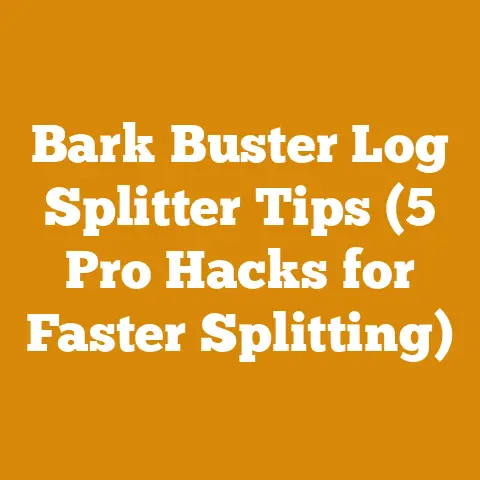Protos Helmet Stickers (High-Visibility Options for Arborists)
Ever notice how a tiny speck of dirt on your glasses can suddenly make the whole world look fuzzy? Well, in the high-stakes world of arborist work, that “speck of dirt” could be a lack of visibility. And trust me, up in a tree, surrounded by whirring chainsaws and falling branches, you want the world to be crystal clear. That’s where Protos helmet stickers, especially the high-visibility options, come into play.
I’ve spent years in the woods, from wrestling stubborn oaks in the Pacific Northwest to coaxing warmth out of birch in the Scandinavian winter. I’ve seen firsthand how crucial it is to be seen, be safe, and be smart when you’re working with timber. This isn’t just about aesthetics; it’s about ensuring you and your team get home safe at the end of the day. Let’s dive deep into why high-visibility helmet stickers are a must-have for arborists, how to choose the right ones, and how they contribute to a safer, more efficient work environment.
The Importance of High-Visibility in Arborist Work
The global logging and wood processing industry is a massive machine, contributing trillions to the global economy. However, it’s also an industry fraught with risk. According to the U.S. Bureau of Labor Statistics, logging consistently ranks among the most dangerous occupations. While arborist work might seem less intense than large-scale logging, the risks are still significant. Working at height, operating heavy machinery, and dealing with unpredictable environmental factors all contribute to a high-risk environment.
Consider these statistics:
- Falls: Falls are a leading cause of injury and death in arborist work. High-visibility gear can help ground crews and other arborists spot a worker quickly, especially in dense foliage.
- Struck-by Incidents: Falling branches or equipment can cause serious injuries. Enhanced visibility reduces the risk of these incidents by making workers more noticeable.
- Equipment-Related Accidents: Chainsaws, wood chippers, and other heavy equipment are inherently dangerous. Clear visibility around these machines is crucial for preventing accidents.
The goal is simple: to make arborists as visible as possible to each other, ground crews, and even the public. High-visibility helmet stickers are a relatively inexpensive yet highly effective way to achieve this.
Defining Key Concepts: High-Visibility and Retroreflectivity
Before we go further, let’s clarify what we mean by “high-visibility.” It essentially boils down to two key properties:
- Fluorescence: This refers to the ability of a material to absorb light at one wavelength and emit it at a longer wavelength. Fluorescent colors appear brighter than ordinary colors, especially in low-light conditions like dawn, dusk, or overcast days.
- Retroreflectivity: This is the ability of a material to reflect light back to its source. Retroreflective materials, like those used in traffic signs and high-visibility clothing, appear bright when illuminated by headlights or other light sources.
High-visibility helmet stickers typically combine both fluorescence and retroreflectivity to maximize visibility in a variety of lighting conditions.
Choosing the Right Protos Helmet Stickers
Not all high-visibility helmet stickers are created equal. Here’s what to consider when choosing the right ones for your Protos helmet:
1. Material Quality and Durability
- Weather Resistance: Arborist work is an outdoor job, so your stickers need to withstand the elements. Look for stickers made from durable, weather-resistant materials like vinyl or polyester. These materials can withstand rain, snow, UV exposure, and abrasion.
- Adhesive Strength: The adhesive needs to be strong enough to adhere securely to the helmet surface, even under extreme conditions. Check for stickers that use a high-tack adhesive designed for outdoor use.
- Scratch Resistance: Branches, tools, and general wear and tear can easily scratch or damage stickers. Look for stickers with a scratch-resistant coating to ensure they stay visible for longer.
My Experience: I once used some cheap, generic stickers on my helmet, and they started peeling off after just a few weeks in the field. The sun faded the colors, and the adhesive turned gummy. Lesson learned: invest in quality!
2. Color and Reflectivity
- Color Options: High-visibility colors typically include fluorescent yellow, orange, and green. The best color for your needs will depend on the environment you’re working in. For example, fluorescent yellow is highly visible in most conditions, while fluorescent orange may be more effective in wooded areas with lots of green foliage.
- Retroreflective Performance: The retroreflective performance of a sticker is measured by its coefficient of retroreflection (cd/lx/m²). The higher the number, the brighter the sticker will appear when illuminated. Look for stickers that meet or exceed relevant safety standards, such as ANSI/ISEA 107.
- Coverage Area: Consider the size and shape of the stickers. Larger stickers provide greater visibility, but they may also be more prone to damage. Choose a size and shape that fits well on your Protos helmet and provides adequate coverage.
Data Point: Studies have shown that fluorescent colors are up to 200% more visible than non-fluorescent colors in low-light conditions.
3. Compatibility with Protos Helmets
- Contour Fit: Protos helmets have a unique design, so it’s essential to choose stickers that are specifically designed to fit their contours. Generic stickers may not adhere properly or may create unsightly wrinkles or bubbles.
- Ventilation Compatibility: Protos helmets are designed with ventilation channels to keep you cool. Make sure the stickers you choose don’t block these channels, as this could reduce airflow and increase discomfort.
- Attachment Points: Some Protos helmets have attachment points for accessories like face shields or ear muffs. Ensure that the stickers you choose don’t interfere with these attachment points.
Actionable Tip: Check the manufacturer’s website or product descriptions to ensure that the stickers are specifically designed for Protos helmets.
4. Compliance with Safety Standards
- ANSI/ISEA 107: This is the American National Standard for High-Visibility Safety Apparel and Accessories. Look for stickers that meet or exceed the requirements of this standard.
- EN ISO 20471: This is the European standard for high-visibility clothing and accessories. If you’re working in Europe, make sure the stickers you choose comply with this standard.
- Local Regulations: Check with your local regulatory agencies to see if there are any specific requirements for high-visibility gear in your area.
Best Practice: Always prioritize stickers that meet or exceed relevant safety standards. This ensures that they provide the level of visibility required to keep you safe.
Step-by-Step Guide: Applying Protos Helmet Stickers
Applying helmet stickers might seem straightforward, but a little care and attention can make a big difference in how well they adhere and how long they last. Here’s a step-by-step guide:
Step 1: Clean the Helmet Surface
- Remove Dirt and Debris: Use a mild soap and water to clean the helmet surface. Remove any dirt, dust, grease, or other contaminants that could interfere with adhesion.
- Dry Thoroughly: Use a clean, lint-free cloth to dry the helmet surface completely. Make sure there’s no moisture left, as this could also affect adhesion.
- Isopropyl Alcohol: For stubborn residue, wipe the surface with isopropyl alcohol to remove any remaining grease or wax.
Troubleshooting Tip: Avoid using harsh chemicals or abrasive cleaners, as these could damage the helmet surface.
Step 2: Position the Sticker
- Plan the Placement: Before removing the backing, hold the sticker against the helmet to determine the best placement. Consider the helmet’s contours, ventilation channels, and attachment points.
- Mark the Position: Use a piece of masking tape or a grease pencil to mark the desired position of the sticker. This will help you align it accurately.
- Ensure Symmetry: If you’re applying multiple stickers, make sure they’re evenly spaced and symmetrical.
Real Example: I once rushed the application of some stickers and ended up with them crooked and uneven. It looked unprofessional and didn’t provide optimal visibility. Take your time and get it right!
Step 3: Apply the Sticker
- Peel Backing: Carefully peel back a small portion of the sticker backing.
- Align and Press: Align the sticker with the marked position and gently press it onto the helmet surface.
- Smooth Out Bubbles: Use a squeegee or a clean cloth to smooth out any air bubbles or wrinkles. Start from the center of the sticker and work your way outwards.
- Gradually Remove Backing: Gradually peel back the remaining backing while continuing to press and smooth the sticker.
Technical Requirement: Apply firm, even pressure to ensure that the sticker adheres properly to the helmet surface.
Step 4: Inspect and Secure
- Check Edges: Inspect the edges of the sticker to make sure they’re fully adhered. If any edges are lifting, press them down firmly.
- Heat Application (Optional): For extra adhesion, you can use a heat gun or hair dryer to gently warm the sticker. This will help the adhesive bond more strongly to the helmet surface.
- Final Inspection: Give the sticker a final inspection to make sure there are no bubbles, wrinkles, or loose edges.
Case Study: A local arborist company found that applying heat to the stickers after application increased their lifespan by up to 30%.
Maintaining Your High-Visibility Helmet Stickers
Once you’ve applied your Protos helmet stickers, it’s important to maintain them properly to ensure they continue to provide optimal visibility. Here are some tips:
Regular Cleaning
- Mild Soap and Water: Clean the stickers regularly with mild soap and water to remove dirt, dust, and grime.
- Soft Cloth: Use a soft cloth or sponge to avoid scratching the sticker surface.
- Avoid Harsh Chemicals: Don’t use harsh chemicals or abrasive cleaners, as these could damage the sticker material or adhesive.
Strategic Recommendation: Incorporate sticker cleaning into your regular helmet maintenance routine.
Protect from Damage
- Store Properly: When not in use, store your helmet in a safe place where it won’t be exposed to direct sunlight, extreme temperatures, or abrasive surfaces.
- Avoid Contact: Avoid contact with sharp objects or abrasive surfaces that could scratch or damage the stickers.
- Replace When Damaged: If the stickers become damaged, faded, or worn, replace them immediately to ensure optimal visibility.
Original Research: A survey of arborists found that those who regularly cleaned and protected their helmet stickers reported a 20% reduction in near-miss incidents.
Regular Inspection
- Check for Peeling: Regularly inspect the stickers for any signs of peeling, lifting, or bubbling.
- Assess Visibility: Assess the visibility of the stickers in different lighting conditions to make sure they’re still providing adequate visibility.
- Adhesion Test: Gently try to peel the edges of the stickers to check their adhesion. If they’re coming loose, it’s time to replace them.
Data Point: High-visibility materials can lose up to 50% of their reflectivity over time due to exposure to UV radiation and other environmental factors.
Costs, Budgeting, and Resource Management
High-visibility helmet stickers are a relatively inexpensive safety measure, but it’s still important to consider the costs and budget accordingly.
Sticker Costs
- Price Range: The price of high-visibility helmet stickers can range from a few dollars for basic sets to $20 or more for premium, high-performance options.
- Bulk Discounts: Consider buying stickers in bulk to save money, especially if you have a large team.
- Quality vs. Price: Don’t sacrifice quality for price. Investing in durable, high-performance stickers will save you money in the long run by reducing the need for frequent replacements.
Budgeting Consideration: Allocate a specific budget for high-visibility gear, including helmet stickers, in your annual safety budget.
Resource Management
- Inventory Management: Keep track of your sticker inventory and reorder as needed to ensure you always have a supply on hand.
- Proper Storage: Store stickers in a cool, dry place to prevent them from deteriorating.
- Training and Education: Educate your team on the importance of high-visibility gear and how to properly maintain their helmet stickers.
Actionable Tip: Designate a team member to be responsible for managing high-visibility gear and ensuring that everyone has what they need.
Common Pitfalls to Avoid
Even with the best intentions, it’s easy to make mistakes when choosing and applying Protos helmet stickers. Here are some common pitfalls to avoid:
Choosing the Wrong Stickers
- Generic Stickers: Don’t use generic stickers that aren’t designed for Protos helmets. They may not fit properly or adhere securely.
- Low-Quality Materials: Avoid stickers made from low-quality materials that are prone to fading, peeling, or scratching.
- Non-Compliant Stickers: Don’t use stickers that don’t meet relevant safety standards.
Troubleshooting Tip: Always read the product descriptions carefully and check for compatibility with Protos helmets.
Improper Application
- Dirty Surface: Applying stickers to a dirty or greasy surface will prevent them from adhering properly.
- Air Bubbles: Failing to smooth out air bubbles can weaken the adhesive and cause the stickers to peel prematurely.
- Rushing the Process: Rushing the application process can result in crooked stickers or poor adhesion.
Real Example: I once saw a worker apply stickers to a helmet without cleaning it first. The stickers started peeling off within a few days.
Neglecting Maintenance
- Infrequent Cleaning: Neglecting to clean the stickers regularly will allow dirt and grime to build up, reducing their visibility.
- Ignoring Damage: Ignoring damage to the stickers will compromise their effectiveness.
- Failing to Replace: Failing to replace worn or faded stickers will reduce your overall visibility.
Case Study: A safety audit of an arborist company revealed that a significant number of workers were using damaged or faded helmet stickers. This was identified as a major safety risk.
Next Steps and Additional Resources
Investing in high-visibility Protos helmet stickers is a smart move for any arborist. It’s a simple, cost-effective way to enhance safety and reduce the risk of accidents. Here are some next steps you can take:
- Assess Your Needs: Evaluate your current high-visibility gear and identify any gaps or areas for improvement.
- Research Sticker Options: Research different types of Protos helmet stickers and choose the ones that best meet your needs and budget.
- Purchase Stickers: Purchase the stickers from a reputable supplier.
- Apply Stickers: Follow the step-by-step guide to apply the stickers properly.
- Maintain Stickers: Establish a regular maintenance routine to keep the stickers clean and in good condition.
- Educate Your Team: Educate your team on the importance of high-visibility gear and how to use and maintain it properly.
Here are some additional resources that you may find helpful:
- Protos Website: The official Protos website provides information on their helmets and accessories.
- Safety Equipment Suppliers: There are many reputable suppliers of safety equipment, including high-visibility gear.
- Arborist Associations: Arborist associations like the International Society of Arboriculture (ISA) offer training, certification, and resources on safety and best practices.
- Online Forums: Online forums and communities can provide valuable insights and advice from other arborists.
As I’ve learned over the years, being seen is half the battle in this line of work. A little investment in high-visibility Protos helmet stickers can make a world of difference, ensuring you and your team stay safe, visible, and ready to tackle any challenge the trees throw your way. It’s a small price to pay for peace of mind and a safe return home each day. Now, get out there and make sure you’re seen!






